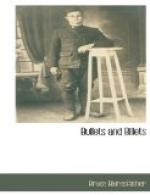The commencement of the journey from the farm of disembarkation lay along what is known as corduroy boards. These are short, rough, wooden planks, nailed crossways on long baulks of timber. This kind of path is a very popular one at the front, and has proved an immense aid in saving the British army from being swallowed up in the mud.
The corduroy path ran out about four hundred yards across the grassless, sodden field. We then came suddenly to the beginning of a road. A small cottage stood on the right, and in front of it a dead cow. Here we unfortunately paused, but almost immediately moved on (gas masks weren’t introduced until much later!).
From this point the road ran in a long straight line towards Messines. At intervals, on the right-hand side only, stood one or two farms, or, rather, their skeletons. As we went along in the darkness these farms silhouetted their dreary remains against the faint light in the sky, and looked like vast decayed wrecks of antique Spanish galleons upside down. On past these farms the road was suddenly cut across by a deep and ugly gash: a reserve trench. So now we were getting nearer to our destination. A particularly large and evil-smelling farm stood on the right. The reserve trench ran into its back yard, and disappeared amongst the ruins. From the observations I had made, when inspecting these trenches, I knew that the extreme right of our position was a bit to the right of this farm, so I and my performing troupe decided to go through the farmyard and out diagonally across the field in front. We did this, and at last could dimly discern the line of the trenches in front. We were now on the extreme right of the section we had to control, close to the River Douve, and away to the left ran the whole line of our trenches. Along the whole length of this line the business of taking over from the old battalion was being enacted. That old battalion made a good bargain when they handed over that lot of slots to us. The trenches lay in a sort of echelon formation, the one on the extreme right being the most advanced. This one we made for, and as we squelched across the mud to it a couple of German star shells fizzed up into the air and illuminated the whole scene. By their light I could see the whole position, but could only form an approximate idea of how our lines ran, as our parapets and trenches merged into the mud so effectively as to look like a vast, tangled, disorderly mass of sandbags, slime and shell holes. We reached the right-hand trench. It was a curious sort of a trench too, quite a different pattern to those we had occupied at St. Yvon, The first thing that struck me about all these trenches was the quantity of sandbags there were, and the geometrical exactness of the attempts at traverses, fire steps, bays, etc. Altogether, theoretically, much superior trenches, although very cramped and narrow. I waited for another star shell in order to see the




